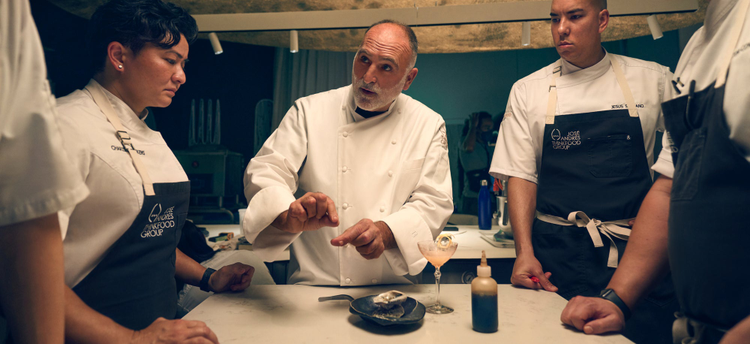Chef José Andrés helps keep restaurants resilient with Adobe Document Cloud

“Food is everything. Food is our history. Food is life. Food is love.”
As restaurants face renewed challenges amidst a long road to pandemic recovery, award-winning chef and entrepreneur José Andrés is committed to helping the industry emerge stronger. He has doubled down on his commitment to major US markets like NYC and Chicago. During the second half of this year, he will be opening an outpost of the Mediterranean restaurant Zaytinya, followed by a branch of the high-end avant-garde dining spot Bazaar in NYC. An outpost of the Spanish tapas spot Jaleo just opened in Chicago back in July, with a new Bazaar Meat concept and accompanying cocktail spot Bar Mar soon to follow.
Each of these new endeavors has been an opportunity to introduce better digital experiences to scale the restaurants — and ultimately move the future of the food industry forward. Chef Andrés relies on Adobe Acrobat DC to check in on the progress and designs of the new restaurants. He views 3D renders of Jaleo, then reviews and comments on the designs — all inside a PDF on his mobile device that his extended team can access wherever and whenever.
“Now we can review and comment on designs in the tablet with different colors. And you can even change your thinking about that photo or that image in a document in real time, in another part of the universe. That’s simple. That’s brilliant, and you can’t beat it,” he said.
Changing the world through the power of food
Chef Andrés believes that food is not only his craft, but also his medium to serve others. And throughout this ongoing global crisis, his non-profit organization World Central Kitchen continues to feed countless people worldwide in the wake of natural and humanitarian disasters. As COVID-19 shook up economies around the world, Chef Andrés and the World Central Kitchen got nimble and creative, deploying innovative solutions and forging local partnerships to feed people in low-income neighborhoods in big cities and support restaurant workers around the country.
“Adversity is when the best of every human being shows up. I decided that the darkness was going to become the light. You want to be there for [the restaurant workers], because you know that they were there for you,” Chef Andrés said.
While the world is not out of the woods just yet, the food industry is beginning to show signs of coming back. Restaurants are finding that the pandemic has irrevocably changed how we live and work. Chef Andrés and his team know this reality all too well. From collaborating on menu designs to hiring and onboarding new employees, Chef Andrés uses digital transformation powered by Adobe Acrobat and Adobe Sign to move his business and the future of the food industry forward.
“Technology helps in so many ways. We used to have to do it with a paper and pencil. Now, <boom>, you have it on your palm,” said Chef Andrés.
What’s on the menu?
If you have dined out over the past year, you have probably noticed that many restaurants no longer use physical menus. Many have started to use QR codes pasted on table signage, enabling customers to view and order menu items from the convenience of their own phones.
“Today we have the option to have QR code menus that you can view on your phone or your tablet. I think this is here to stay and this is a good addition. It’s a paper-like experience, only better and more convenient,” said Chef Andrés.
Here’s the problem, however. Viewing and navigating through a comprehensive menu on a tiny mobile device can be a challenge to human eyes. With Liquid Mode, a revolutionary mobile reading experience powered by Adobe Sensei inside the Adobe Acrobat Reader mobile app, patrons of Chef Andrés’ restaurants can easily view PDF versions of the menu on their phones. Liquid Mode automatically reformates the text, images, and fonts on the menu, making consumption much easier on small screens.
And if Chef Andrés and his team need to update dishes and drinks on the menu, they can simply use the Edit PDF tool in Adobe Acrobat DC. Edit PDF enables them to change text and even images right inside the PDF menu with a simple click or tap. They can also make those edits from anywhere with the Acrobat Reader mobile app.
The “signature” ingredient
Chef Andrés’s restaurants are global, which means that he works with team members and vendors around the world. When managing accelerated timelines for opening new restaurants, Chef Andrés and his team rely on Adobe Sign e-signatures to manage complex contracts and onboard new employees no matter where they are.
“Electronic signatures, quite frankly, are great. I don’t understand how we used to sign before. That’s how fast and how much technology is helping us to keep moving,” he said.
Coming back — New and stronger
The past year has shown a need for businesses of all sizes to quickly adapt and shift the way that they work. It is especially important for global businesses like the one Chef Andrés runs. As he continues to expand the footprint of his restaurant empire, Chef Andrés expects that hybrid work — in-person and remote collaboration — will only grow post-pandemic. By leaning into digital tools from Adobe Acrobat and Adobe Sign, Chef Andrés and his team can still work quickly and efficiently together even if they are apart.
“Restaurants restore who we are each day. When a restaurant is safely open, it’s sending a message that the entire system is back,” he said.